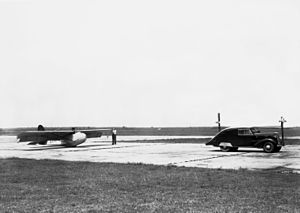Franklin PS-2
| PS-2 | |
|---|---|

| |
| Franklin PS-2 training glider is about to be towed aloft by the specially modified car in front. | |
| Role | Glider |
| National origin | United States |
| Manufacturer | Franklin Glider Corporation |
| Designer | R. E. Franklin |
| First flight | 1930 |
| Introduction | 1930 |
| Variants | Stevens SU-1 |
The Franklin PS-2 is an American, high-wing, strut-braced, single seat, glider that was designed by R. E. Franklin and produced by the Franklin Glider Corporation starting in 1930.[1][2]
Design and development
[edit]The prototype PS-2 was the 50-foot (15 m) wingspan Texaco Eaglet, flown in 1930. The production PS-2 had shorter 36 ft (11.0 m) wings.[1][2]
The PS-2 is constructed with a steel tube fuselage and a wooden wing, all covered in doped aircraft fabric covering. The wings lack spoilers of other glide-path control devices and are supported by dual, parallel struts. The landing gear is a fixed monowheel and a skid.[1][2]
Operational history
[edit]
The prototype Eaglet performed a number of long tows, including one flown by Frank Hawks from California to Elmira, New York in 1930[3] and is now in the National Air and Space Museum.[1][2]
In 1934, the PS-2 was the glider of choice for the Lustig Skytrain experiment. The concept was to tow three gliders in tandem, taking off from New York City and releasing one each over Philadelphia, Baltimore and Washington, D.C. The gliders were piloted by Jack O'Meara, PS-2 designer R.E. Franklin and Stan Smith. The Skytrain was intended to be a proof-of-concept for a future airline service, but was not pursued.
The PS-2 was also used in 1934 for a United States Navy primary flight training experiment in Pensacola, Florida, designed by Ralph Barnaby[1][2]
The PS-2 was also flown by many early glider pilots including Richard Chichester du Pont, Warren Eaton, Floyd Sweet and Stan Smith.[1][2]
In 1983, two were reported as being still flown and one was under restoration by the designer's son, Chuck Franklin.[2] The Federal Aviation Administration had seven PS-2s registered in March 2011, including the Franklin-Stevens PS-2.[4]
Variants
[edit]- Texaco Eaglet
- Prototype with 50-foot (15 m) span wings[1][2]
- PS-2
- Production model with a 36 ft (11.0 m) wingspan[1][2]
- Franklin-Stevens PS-2
- Modified model[5]
- TG-15
- United States Army Air Corps designation for eight PS-2 gliders impressed as training gliders in 1942.
- TG-17
- United States Army Air Corps designation for one PS-2 gliders impressed as a training glider in 1942 (serial number 42-57193).[6]
Aircraft on display
[edit]- National Air and Space Museum[1][2]
- National Museum of Naval Aviation[1]
- National Soaring Museum - four, plus one Franklin-Stevens PS-2[5]
- US Southwest Soaring Museum[7]
- Yankee Air Museum, Belleville, Michigan[citation needed]
Specifications (PS-2)
[edit]Data from Sailplane Directory and Soaring[1][2]
General characteristics
- Crew: one
- Wingspan: 36 ft 0 in (10.97 m)
- Wing area: 180 sq ft (17 m2)
- Aspect ratio: 7.2:1
- Empty weight: 220 lb (100 kg)
- Gross weight: 400 lb (181 kg)
Performance
- Maximum glide ratio: 15:1
- Rate of sink: 150 ft/min (0.76 m/s)
- Wing loading: 2.22 lb/sq ft (10.8 kg/m2)
See also
[edit]
References
[edit]- ^ a b c d e f g h i j k Activate Media (2006). "PS-2 Franklin". Archived from the original on April 5, 2012. Retrieved March 24, 2011.
- ^ a b c d e f g h i j k Said, Bob: 1983 Sailplane Directory, Soaring Magazine, page 12. Soaring Society of America, November 1983. USPS 499-920
- ^ "Franklin "Texaco Eaglet"". National Air and Space Museum. Archived from the original on December 24, 2015. Retrieved December 31, 2014.
- ^ Federal Aviation Administration (March 2011). "Make / Model Inquiry Results". Archived from the original on June 14, 2012. Retrieved March 24, 2011.
- ^ a b National Soaring Museum (2011). "Sailplanes in Our Collection". Archived from the original on May 16, 2011. Retrieved February 26, 2011.
- ^ Heyman, Jos (February 1, 2015). "Training Glider (1941-1947)" (PDF). usmilitaryaircraft.files.wordpress.com. Archived (PDF) from the original on July 12, 2019. Retrieved March 13, 2022.
- ^ US Southwest Soaring Museum (2010). "Sailplanes, Hang Gliders & Motor Gliders". Archived from the original on November 20, 2022. Retrieved May 26, 2011.
